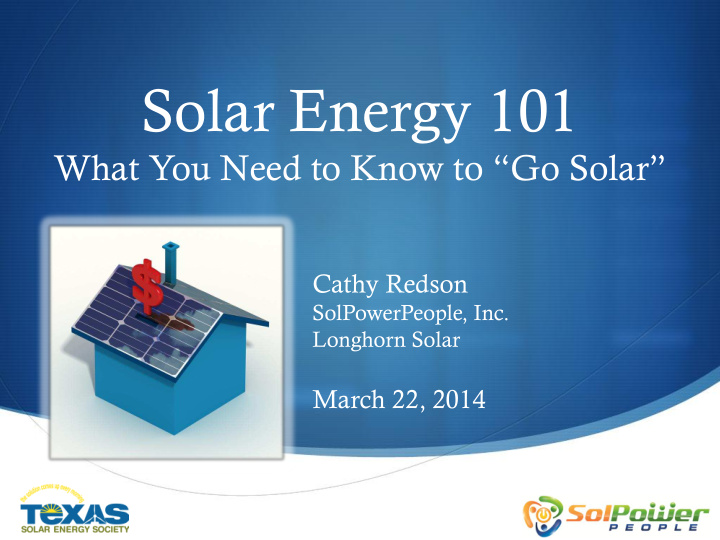



Solar Energy 101 What You Need to Know to “ Go Solar ” Cathy Redson SolPowerPeople, Inc. Longhorn Solar March 22, 2014
Solar Energy: Power to the People Solar Radiation Solar Energy Applications Types of Solar Energy Systems Installing Solar on a Home or Business Solar Energy Economics
What if? 25 year warranty! FREE fuel! No Maintenance (o.k., keep it Image: toondraw.com clean!!!) Millions of Jobs! Invented/Made in the USA! 3 year “ energy payback ” What would you be Freedom to go wherever you WILLING to pay? want, whenever you want!
What if it was not a car, but a HOME energy system? 25 year warranty! FREE fuel! No Maintenance (o.k., keep it clean!!!) Millions of Jobs! Invented/Made in the USA! 3 year “ energy payback ” Energy Independence! What would you be WILLING to pay?
bestgreenenergyguide.com
What is Solar Energy? khadley.com Nuclear fusion at core of sun releases PHOTONS or “ Light ” Energy Visible light particles that scatter in all direction and land on Earth ’ s surface Provides enough energy in 1 hour to power the entire globe ’ s energy needs for 1 year! Thermal or “ Heat ” Energy Energy transmitted as infra-red waves from a heat chemistry.need.org source (sun) to cooler object (earth) Energy or heat loss is minimal, because it travels as a light wave
Solar Energy Technologies Photovoltaics (PV) Systems: Solar Electricity boataddicts.net Solar Thermal Systems: Solar Hot Water Concentrating Solar Collectors Use reflective mirrors to increase sun ’ s energy Only works in direct sunlight because solar cell faces mirrors, not sun Concentrating Solar Photovoltaic systems jcwinnie.biz Concentrating Solar Thermal systems Usually utility scale
Photovoltaic Systems
Solar Thermal Systems
Solar Thermal Systems Solar Hot Water System Fastest payback of any solar technology! Residential system: $3,000 to $6,000, 1-3 yrs., compared to cost of electric hot water heating New/Replace or “ front-end ” to existing system Pool heating Radiant Heating Systems Integrated with walls/flooring
Crystalline Silicon
Building Integrated PV (BIPV) – Also Thin Film POWERHOUSE Solar Shingle ustile.com-solar-shingles
Residential Rooftop or Awning
Pole or Ground Mount
Typical Attachments
Metal Roof Attachments
Equipment Wall • Dual SMA 5000 Watt Transformerless Inverters • New emergency plug can run off of solar PV array, when grid goes down, up to 1500 Watts
Micro Inverters & DC Optimizers Module Level Electronics that maximize energy harvest of each solar panel
ACPV Modules-Almost Plug ‘ n Play • Austin-based SolarBridge Technologies • Factory-installed DC-AC module component • Complies with UL 1703 & 1741 Standards • 25 year warranty
PV System Advantages Reliable – Est. 40 year life, warranty typically 20-25 years No moving parts! – minimal maintenance (cleaning, inspect system) No special wiring or changes to existing electrical system Locks in energy price for life of system No fuel charges, no noise, no pollution
Types of PV Systems Grid-Tied Off-Grid Direct PV – water pumps, fountains Off-Grid Homes – AC and other regular electrical loads Grid-Tied with Battery Back-up
Site Assessment Southern-facing roof (East to West o.k., NEVER North!) Minimum 6 hours per day of direct sun Condition of Roof Ground or Pole Mount systems Existing Electrical System Accessibility
Insolation = “ Peak Sun Hours ” Peak Sun Hours means the Irradiance in w/m 2 equivalent number of hours if the intensity of the sun remained at a constant equal to the intensity at Peak Sun Hours noon on most places on Earth, which = 1000 w/m 2 Sunrise Noon Sunset Time of Day
Sun Angle vs. Intensity Lower angle causes radiation to be received over larger area, reducing intensity Citation: Pidwirny, M. (2006). "Earth-Sun Relationships and Insolation". Fundamentals of Physical Geography, 2nd Edition. Date Viewed. http://www.physicalgeography.net/fundamentals/6i.html
Planning, Designing & Managing Your Installation Installation should be done by Qualified Personnel UL Listed equipment – modules, inverters, electrical equip. Look for NABCEP Certification and Licensed Electrician, get license number and check for complaints Protect your Roof Warranty!!! Just like any “ home improvement ” Check references & local installations Check for bonded & insured, workman ’ s comp, etc. Install Crew – NABCEP Certified Installer ONSITE supervising TRAINED workers with EXPERIENCE
PV Economics Payment Options Upfront payment Loan – short term, home equity loan, refinance Typical system price ~ $3.00/watt Varies depending on complexity of installation
Usage Determines PV System Size Gather 12 months Energy Bills Look for highest, lowest, and average monthly usage in kWh Average home: 1,200 kWh/mo = 14,400 kWh/yr. PV System Sizing Formula: Monthly kWh ÷ 30 days ÷ 5.3 PSH ÷ .77 = PV System Size in kW Space Required = approx. 100 ft 2 for every 1,000 AC Watts of PV
Residential Grid-Tied Example Typical Single Family Homeowner: 3-4 member household, uses 1200 kWh Wants 50% of energy needs met by PV System Wants “ Made in America ” equipment 600 kWh AC ÷ 30 days ÷ 5.3 PSH ÷ .77 = 4,900 W DC of PV Using (2) strings of (12) Sharp 240W modules & SMA Sunny Boy 5000 Watt Inverter, at 13.7 w/ft 2 = 420 ft 2 5,760 W x .77 x 5.3 PSH x 30 days = 705 kWh AC per month
PV Incentives & Financial Considerations CTEC Net Metering – Single Meter! 30% Federal Investment Tax Credit until 2016 Special incentives for businesses: 5 year MACRS To compare as investment to other investments, be sure to adjust after-tax savings vs. pre-tax return on other options
Example – PV System Cost Assumptions: PV system cost of $3.00/watt 30% Investment Tax Credit 25 year Warranty (however, expected life > 40 years!!) Cost: 5,760 DC Watts @ $3.00/watt: $17,280.00 Less 30% Investment Tax Credit: ( 5,184.00) Net Cost: $12,096.00 705 kWh x 12 mos x 25-yrs @ $.086/kWh: $18,189.00 Or, $12,096 ÷ (705 kWh x 12 mos. x 25 yrs.): $.057 / kWh
Thank You! Contact Information: Cathy Redson (512) 547-8084 credson@solpowerpeople.com SolPowerPeople, Inc. info@solpowerpeople.com 855-SOL-POWER (office)
Recommend
More recommend